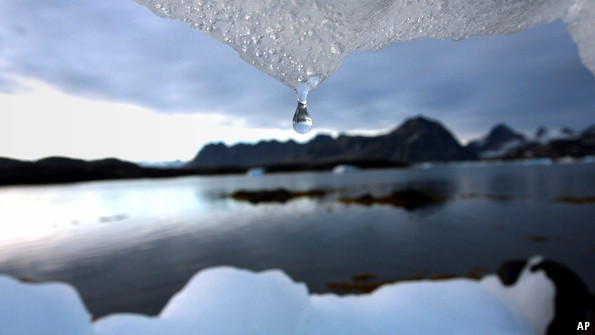Stubborn things
By all means question climate policies. But facts are facts

IN 2007 the Intergovernmental Panel on Climate Change (IPCC), a body of scientists, said the glaciers of the Himalayas could melt by 2035. This was complete fiction. It also said global surface temperatures would go on rising by about 0.2°C a decade for the next 20 years. They have been more or less flat since 1998. The IPCC has now issued its sextennial check-up on the health of the global climate (see article). Why would anyone believe what they say?
Because there are climate facts—and facts are stubborn things. One is that the upper 75 metres of the oceans have warmed by 0.1°C a decade in the past 40 years and there is no sign of this slowing down. Water expands, and ice melts, as temperatures rise, so sea levels have risen 19cm in the past century and the Arctic sea ice has shrunk by about 500,000 square kilometres a decade since 1979.
These facts matter because the oceans cover seven-tenths of the Earth’s surface and are its primary heat sink (90% of the extra warming over the past 40 years has gone into the oceans). By most measures—though not all—global warming is continuing.
But what about the pause in air temperatures? Isn’t that a fact? Indeed it is. But right now it matters more to climate science than climate policy. The extent of the pause is sensitive to the starting-point chosen when defining it. The recent temperature peak was 1998. The world has warmed by 0.05°C a decade since then, only a quarter of the rise the IPCC forecast. But in 1998 El Niño, an occasional warming of the Pacific Ocean which boosts temperatures around the planet, was unusually large. If you start in 2000 and compare the decade of the 2000s with the 1990s, you find that the IPCC estimate was close. This does not mean the pause does not exist. But it is more or less striking depending on where you view it from.
More important, it is not clear yet how much weight to give to a 15-year period. Half a generation is long enough to come to a judgment on most things. But climate cycles last hundreds, or tens of thousands, of years. It used to be a rule of thumb that climate scientists wanted 30 years of observations before judging that something was a trend, rather than a fluctuation. Partly for that reason, they were slow and reluctant in taking the temperature hiatus seriously.
The decade-and-a-half to 2013 was unusual because it also saw a big rise in carbon-dioxide emissions, which, all things being equal, should have pushed up temperatures everywhere, and didn’t. And that raises important questions: why have sea temperatures risen but not air temperatures? Is more heat going into the deep oceans? Is the climate reacting more slowly to rising concentrations of CO2? But these are questions about how the climate is changing, not whether it is. They do not yet mean global warming itself has hit the pause button.
Don’t shoot the messenger
Imagine an economy that has been overheating for a decade and suddenly experiences two quarters of flat growth. All other indicators—household debt, employment, the trade deficit—are still signalling a boom. How should one react? Policymakers might say the situation needs watching or that the relationship between GDP and debt or employment might be changing. But it would be reckless to declare that overheating is at an end or to abandon attempts to cool the economy.
Some worries about global warming are prompted by the extravagance of some climate policies. In particular, European subsidies for solar and wind, which are hugely expensive, are doing little to cut emissions. But reservations about the policies should not be used as reasons for denying the facts
No comments:
Post a Comment